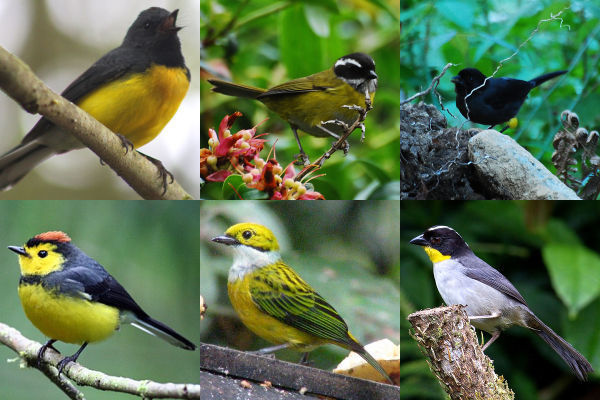
Did I tell you I live in Pittsburgh where the Steelers are playing the AFC Championship game this Sunday?
It’s a rare day that bird anatomy is related to the Steelers, but today is that day.
For many weeks I’ve been using Frank B. Gill’s Ornithology to inspire Friday’s anatomy lesson. Rather than read the whole book I open the index at random and with my eyes closed I point to a word. Then I look up that word and find something interesting to write about. Today’s word was “Yellow-throated Brush Finch, page 328.”
Page 328 discusses the advantages of multispecies flocking. Many species form mixed flocks because they get more to eat when there are many eyes watching for danger. In Pennsylvania we often see mixed flocks in winter led by titmice and chickadees. The leader species are dominant, the others follow.
Some birds go one step further. Ornithology describes how in some mixed flocks “unrelated bird species have similar plumage color patterns that promote flock cohesion. Subordinate species increase acceptance by resembling dominant flock members.”
These distinctive color patterns are called flock “badges.”
The yellow-throated brush finch (bottom right) is a member of one of these unusual flocks in Western Panama. His compatriots are all black and yellow.
As I assembled this photo, I suddenly realized that the brush finch and all his friends are wearing Steelers colors. It’s a whole flock of black-n-gold birds! How cool is that?!
So this is what we look like in Pittsburgh right now. We’re wearing our Flock Badges, black-n-gold!
.
(composite photo credits, top left to right, then bottom left to right:
1. Slate-throated Whitestart: Corey Finger on 10000birds.com
2. Sooty-capped Bush Tanager: Wikipedia
3. Yellow-thighed Finch: Wikimedia Commons
4. Collared Whitestart: Jan Axel on janbirdingblog.blogspot.com
5. Silver-throated Tanager: Kent Fiala’s Website
6. Yellow-throated Brush Finch: Atrevido1 at Solo Aves on Flickr)
Wow….I personally never knew why the different species flock together. I am also looking forward to March 7th. I don’t know any of you but I’m looking forward to meeting you. I have my flock badge on today too! Go Steelers….What a morning in the burgh….1 1/2 to get to work.
Such a timely & “right color” message in this one; Sorry I cnnot make that peregrine date in March, no caregiver sub. I can get to leave my hubby in evenings. But I will wish you a wonderful turnout for it.
Mixed flocks are something I’d never considered until a post of yours on chickadees last fall. And now this example is really extraordinary.
Your mention of birds and Steelers though requires me to mention the crested oropendola. They have a pair at the National Aviary and I’ve even heard one or two of the trainers refer to them as their “steelers birds.”
I don’t think these guys would fit into the above flock one bit though. They’re almost as large as crows.
Crested Oropendola @ Aviary – http://www.flickr.com/photos/87087391@N00/sets/72157625748223293/detail/
Don’t forget the Yellow-headed Blackbird.
Also, there is the male Three-toed Woodpecker. Lots of birds must be Steeler fans.
Several wood-warblers come to mind. Kentucky Warbler fits. So does Hooded Warbler. And Mourning Warbler and MacGillivray’s Warbler as well (the gray closely approaches black in adult males). Common Yellowthroat. Yellow-throated Warbler. Some New World orioles (icterids) also fit — Scott’s Oriole, Eastern Meadowlark, Western Meadowlark. This is getting fun!
glad to see that these are not birds readily observed in the continental united states.
i thought i was losing my hard earned birding skills as i could not identify any!
I can’t resist adding one more wood-warbler, perhaps, the “piece de resistance” —
Golden-winged Warbler! They’re all in southern Central America and northern South America now, but maybe, just maybe, they’re rooting for us.
Now this is a cool friday lesson. Thank’s for sharing and GO STEELERS:)
Kate, is it too early to be hearing birds (other than crows) singing in the early morning? As I was clearing the snow off of the car AGAIN this morning, I could swear I heard a springtime-like song. Maybe it’s just wishful thinking on my part!
GO STEELERS!!
It’s not too early. You might be hearing a Song Sparrow or Carolina Wren. They don’t sing all day yet, but they have already noticed that the days are longer.
A Cooper’s hawk has found it’s way into the Library of Congress. Thought I’d share with the rest of you bird fans. There’s pictures and some awful humor in their post about it.
http://blogs.loc.gov/loc/2011/01/watching-our-researchers-like-a-hawk/
And an update from today was just posted…
http://blogs.loc.gov/loc/2011/01/and-watch-a-hawk-makin-lazy-circles-in-the-dome/
I doubt this blog is on many birder’s watchlists.
Did you know there are 53 jets coming to take the Pittsburgh Steelers to Dallas?!
Thanks for the hawk in the Library of Congress story, Peter — and if she hasn’t been named yet, I suggest “Kitty” Hawk!
We won! On to the Super Bowl!